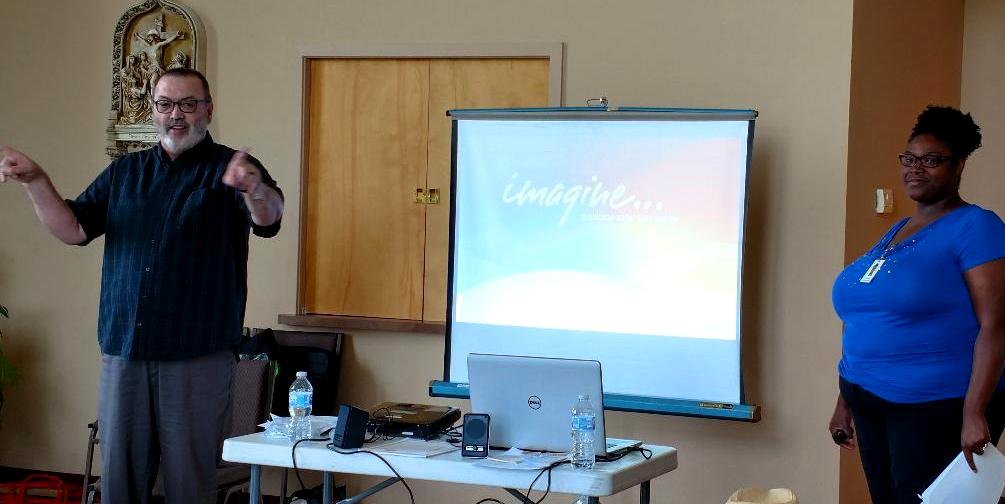Pam Dudding-Burch
Contributing writer
Preventing a person from ending their life could be one of the most important things a person could ever do. Despite thinking it, many people with those thoughts do not go through with it. Unfortunately, the same can’t be said for everybody.

“Most people with thoughts of suicide don’t truly want to die, but are struggling with some type of pain,” J.D. Carlin, the Craig County Prevention Planning Team (CPPT) Secretary, said. Carlin is also a Prevention and Wellness Specialist with Blue Ridge Behavioral Healthcare.
Recent Craig County statistics have shown that suicidal thoughts and attempts are happening in Craig County at levels higher than the national average, To address the issue, CPPT recently hosted a free safeTALK training session to help people to become more aware of the possible signs of suicide.
Research shows that suicide is the second leading cause of death among people between the ages of 15-24. More than 43,000 Americans commit suicide each year. For every person who succeeded, 25 others attempted, according to the CPPT.
On Thursday, June 23, roughly 20 Craig County residents took advantage of the free training that was held at St. John’s Catholic Church, all hoping to gain information that no one ever wants to have to use.
It was mentioned that suicide “occurs when stressors and health issues converge to create an experience of hopelessness and despair.”
“This seminar is alertness training that prepares anyone fifteen or older, regardless of prior experience or training, to become a suicide-alert helper,” Carlin said.
Two experienced safeTALK trainers, who are Prevention Wellness Specialists with Blue Ridge Behavioral Health, lead the training.
Janis Carpenter has worked in the field for five-and-a-half years, exemplifying her observable knowledge throughout the course. Ray Bemis has been in the business for 29 years, and shared many examples of what to and not to do from his vast experiences.
“The key takeaway from safeTALK for attendees is being able to identify possible invitations (or indicators) of suicide and being more comfortable talking about the topic within their community,” Carpenter said.
Additional information was shared in the three-hour training course.
The one comment that was repeated was, “Always be direct when speaking with someone about suicidal thoughts.” Many consider it “being nosey” to do so, but most agree that suicidal thoughts or attempts are very serious and real. The team shared that in their years of experience, suicide thoughts can only be dealt with indirect communication.
One may ask, “Have you had thoughts about suicide?” or “Are you thinking about ending your life?” Carpenter stressed, “Remember, life ends at suicide.”
Both trainers shared that sometimes that person just needs to hear those words out loud. And, often, it’s at that time that they truly open up to someone for help.
They noted that “a community that will talk about suicide can talk about all kinds of things, which in turn, creates a suicide-safer community.”
“People we love and care about are suffering, and they need our help,” Carlin added. “This training gives a person the skills they need to make a difference at a possible pivotal moment in one’s life.”
The trainers also shared many signs of people contemplating hurting themselves or wanting to end their life. “Be attentive to people who become distant in relationships, start avoiding getting involved or become moody or overly a class clown, start abusing alcohol or drugs, or seem desperate, hopeless or ashamed,” they said.
Janis and Ray discussed four steps which they call TALK; Tell, Ask, Listen and KeepSafe and added not to promise secrecy.
“Most everyone who has had a suicidal thought has told someone,” they said. It is then that they are giving the hearer an open door to ask the direct question and listen to their story. “Our job is to help someone save their own life,” Janis said.
After one listens and has a conversation, clarifying the person’s feeling and possible actions, they can direct them to the right kind of help to keep them safe and prevent them from harming themselves.
“I was thrilled with the way the safeTALK training went and appreciate greatly everyone who set aside the time to participate and learn about preventing suicide, especially in Craig County,” Carlin said. “CPPT wants to do all it can to help educate the community and have a positive impact on concerns such as suicide.”
For more information, visit https://www.livingworks.net/programs/safetalk/ and www.craigppt.org.
There is also a new program where people can text with a trained counselor from the Crisis Text Line for free, 24/7. Text TALK to 741741.
Also present at the training was Tracy Whittaker, a licensed clinical social worker who serves Craig County. “I have been working in the mental health field for 18 years,” she said.
Tracy invites anyone who has any concerns to visit her at the office. Hours in Craig are as follows; Mondays 9 a.m. to 6 p.m., and Tuesdays through Thursdays from 9 a.m. to 5 p.m.



